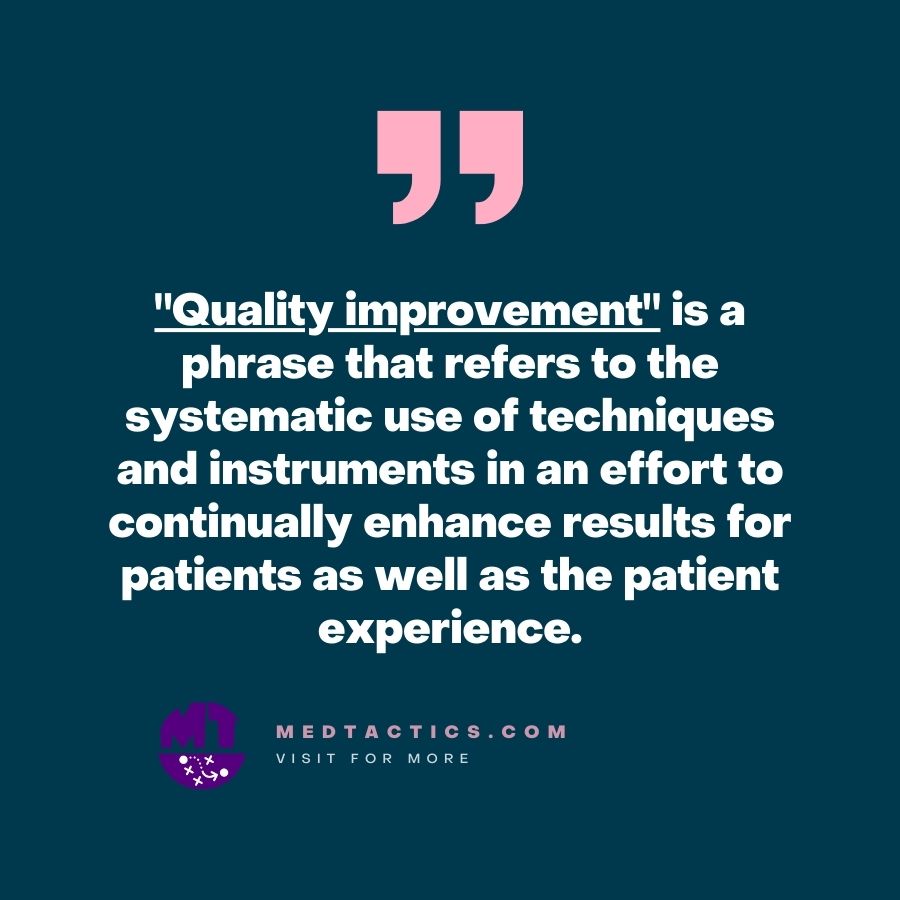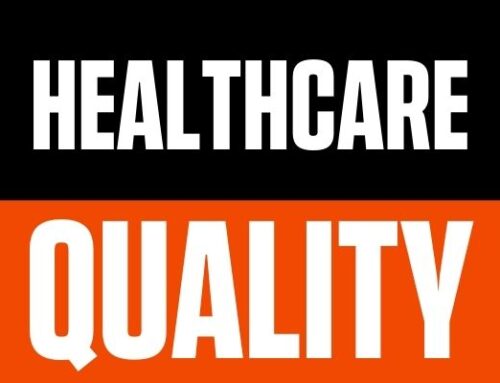What are examples of quality improvement in healthcare?
The field of healthcare quality is quite vast. When looking at what are examples of quality improvement in healthcare, it helps to first understand what quality is. Quality is a standard of behavior that is intended to be upheld by people who work in healthcare. Healthcare quality is extremely important because the quality of healthcare services can determine whether a patient is given the care they need or if the care they receive is of a poor quality. Below are some examples of quality improvement in healthcare.

Quality improvement in healthcare is defined as follows:
“Quality improvement” is a phrase that refers to the systematic use of techniques and instruments in an effort to continually enhance results for patients as well as the patient experience.
It is imperative that healthcare systems take into consideration the preferences of the patient. When quality improvement is done well, the system can provide the service the patient needs while being affordable. When healthcare systems perform poorly, they cannot give the best possible service to their patients because they have not considered the preferences of the patients. In order for quality improvement to work in the healthcare system, it is important that priorities are given to the preferences of the patients.
Why should we be interested in any of this? All things considered, that seems like dull managerial jargon. However, if we delve a little further, we will find that it is really very fascinating. It all boils down to a mindset of how to make things better in the healthcare industry. Because of our own personal experiences, we are all aware of how much space there is for change in the healthcare system.

What are examples of quality improvement in healthcare?
The most frequently used quality improvement models in healthcare are Lean, Total Quality Management, Kaizen, and the Institute for Healthcare Improvement’s Model for Improvement.
What are examples of quality improvement in healthcare? When quality improvement occurs, it is important that the focus is not just on reducing costs but improving the quality of the overall patient care. One way to improve the quality of patient care in a hospital setting is to choose the best team members and staff members that work together effectively. Healthcare quality improvement can also take place when hospital administrators and leaders take a look at the administrative side of the business and try to find ways to streamline the process and reduce the amount of paperwork involved.
KAIZEN / TQM / LEAN
Kaizen is a process that aims to enhance the overall performance of a company by establishing a standard method of working, improving efficiency, and reducing corporate waste.
The cultural component of total quality management is also taken into consideration. Inspire by Armand Feigenbaum’s book Total Quality Control, it reexamined quality control methods and how such techniques had been effectively utilized in the Japanese manufacturing industry. TQM received significant attention throughout the late 1980s and early 1990s before being eclipsed by other quality management systems such as ISO 9000, Lean, and Six Sigma.
The Toyota Production System was created by Taichi Ohno, who is credited with inventing the Lean manufacturing paradigm. A lean organization is one that places a strong emphasis on reducing waste and optimizing processes. Lean is also about cultivating a culture, one that values and respects all workers, and one that encourages them to seek out chances to enhance their job and to share ideas for continuous improvement with one another.
What are examples of quality improvement in healthcare? -1
Continuous quality improvement in nursing may be broken down into a few main categories:
Quality Assurance: This guarantees that the services provided by your company satisfy the necessary criteria for providing quality healthcare.
Quality Improvement: This guarantees that everyone in your company, in every area, is always striving to provide better healthcare to patients.
Problem Solving: This guarantees that all of your organization’s departments communicate with one another and collaborate effectively.

Additional thoughts on what are examples of quality improvement in healthcare?
The first step in quality improvement in healthcare is for healthcare professionals to use data to help them better understand patient needs. Healthcare quality improvement is accomplished when data on the demographic, financial status, medical history, medicines prescribed and other things are gathered to help healthcare professionals make quality decisions on each patient. This can include the use of software to gather information on what patients are paying for and what their history is when it comes to healthcare services. Software can also be used to create a database of patient history so that when a new patient comes in, their past record can be pulled up quickly.
Another area that healthcare quality improvement professionals can focus on is keeping the facility safe. By using appropriate staffing and equipment, safety in healthcare facilities is improved. Medical supplies and devices should be kept as clean as possible to keep infections from spreading. Staff should also practice good safety habits such as wearing gloves when moving equipment or cleaning areas. Staying up-to-date on safety standards can reduce injuries on the job and help to ensure the protection of patient health.
The third area of quality improvement in healthcare is patient safety. Properly measuring patient safety includes avoiding any injury to staff as well as to patients during surgical procedures. Specific measurements can be made with ultrasound or patient safety cameras to help achieve this goal. Healthcare quality improvement professionals may work to prevent unwanted incidents by implementing policies such as pre-surgical reminders, safe procedure alarms and patient education. Installing alarms may be one of the most important steps because if someone is injured while on the job, they will have contact with the company and they may not want to return to work.

Long-term healthcare quality improvement involves ensuring that the system is able to sustain itself in the long run. There are many ways to judge this, such as making sure that emergency measures have been implemented, ensuring that prescriptions are issued promptly and that there are enough physicians and nurses on hand at all times. Providers should also strive to keep records of patient medications, both long-term and short-term, so that it is easy to keep track of their long-term treatment history. By staying informed about the services provided and the success rates, quality leaders can work to improve the hospital’s overall level of care.
What are examples of quality improvement in healthcare? -2
An answer to this question will vary depending on who you ask. If you are a healthcare professional looking to better understand quality improvement, it is helpful to define the concept yourself. Quality improvement means improving quality of life and enhancing the patient’s satisfaction with their healthcare. This improvement takes place through the identification and analysis of issues that are hindering quality of life and the improvement of those areas. Examples of quality improvement include caregiver education, new equipment and procedures, staffing and work practices among other areas.
When looking to improve quality in health care, healthcare professionals are faced with the challenge of developing and maintaining quality improvement programs that address a wide range of situations. A good example is the area of QI. Quality improvement in healthcare also takes into account quality assurance or ensuring that a procedure or equipment is operating within the parameters of acceptable levels. Examples of quality improvement includes statistical monitoring, clinical directives, regulatory guidelines, and new procedures and equipment.
A quality management approach is used to identify areas of need and create plans to address them. A clinical outcomes statement is created based on the observations of the staff as well as the results of the analysis and research conducted. Clinical outcomes are then presented to management outlining what needs to be done to improve quality and establish realistic targets. In the planning process, the organizational vision and mission statement along with a list of tasks and milestones are assessed to determine if they are aligned with the organization’s strategy and resources. The key drivers behind these organizational visions and missions are then included in the organizational documents outlining the quality standards.
Another area of focus for quality improvement projects is healthcare cost and practice management. Healthcare costs are increasing due to an aging population and an increase in diagnosis and treatment. Healthcare providers face increasing demands for higher quality services because of the competition in the health system. Healthcare providers have to work harder to attract, retain, and engage their patients. Healthcare cost performance is directly tied to these factors and the use of analytics helps healthcare systems to achieve better efficiency.
Work in healthcare quality improvement requires a certain set of abilities
First and foremost, the QI expert need a combination of interpersonal and analytical abilities. This is best appreciated by considering some of the skills and abilities that a quality improvement expert will be required to possess:
Obtaining information from the institution about clinical outcomes and other factors.
Comparing and contrasting the many ways of providing and managing care.
It is necessary to identify problems that continue to emerge on a regular basis and then solve those difficulties.
Examine all relevant rules, regulations, and compliance problems, and then determine whether or not they are being fulfilled at the facility in question.





Data-driven process improvement measures are used to analyze existing data, identifying patterns and trends that point to possible issues or areas for improvement. By applying standard statistical analysis and creating aggregates (comparable items) that can be used to measure quality at different levels of the organization, a data-driven approach lowers the length and breadth of the analysis. Analysis produces charts, tables, maps, and graphics that show quality improvements over time and areas of focus for improvement. The dashboard analytics provide real-time alerts that provide data up to the minute on improvements by using historical data, case studies, prototypes, and other statistical tools.
Another example of quality improvement is systematic reviews. A systematic review is a controlled, evidence-based approach to evaluating the effectiveness of health care interventions or treatments. Health systems need to conduct systematic reviews to determine what practices are effective, what are no longer effective, or what worked before but not anymore. In addition to improving quality of care, systematic reviews reduce unnecessary stress on staff, improve collaboration among staff, generate accurate and useful patient-based data, and improve the accuracy and utility of health information systems (HRISs). HRISs integrate and exchange data from various sources so that physicians can make improved decisions and provide improved services.
While it is important for organizations to perform quality improvement activities, quality assurance activities are usually conducted on smaller fronts, such as improving communication or increasing staff productivity. These activities are more time-consuming and therefore less likely to yield significant results. If medical errors are causing a delay in treatment or if treatment is not successful because of a lack of quality, then these actions are less likely to be successful. However, when they are performed in a larger fashion, with the help of large and small projects respectively, then a significant amount of improvement in the quality of health care can occur.
If quality improvement in healthcare is something you are interested in, then there are some excellent examples of quality improvement that you should definitely learn about. When it comes to improving quality in healthcare, one of the most important factors to consider is making sure that all of the people in the healthcare industry have access to high-quality education and training. This includes nurses, doctors, and even staff on the front lines of care. A nurse’s job involves providing ongoing health care to patients with a wide range of conditions, so it is only logical that she or he would need to learn new ways to provide quality care. Doctors, on the other hand, have a very important role to play in ensuring that patients receive proper health care, so they also need to know all about quality improvement in healthcare.
How can quality improvement in healthcare help patients? The goal of quality improvement is to ensure that all patients have positive clinical outcomes, which includes both their physical and mental state. This is especially important in the case of those who receive treatments that are risky, life-threatening, or otherwise cause them extreme discomfort. For these patients, simply being able to think clearly is often enough to prevent physical complications, which can put their lives and their health at risk.
What are examples of quality improvement projects in healthcare? Healthcare quality improvement projects can include anything from improving hospital beds to improving the equipment that nurses and doctors use in the operating room. Healthcare organizations spend millions of dollars every year trying to find innovative solutions to improve clinical outcomes. One of the best ways to ensure that healthcare organizations have access to this capital is through the use of analytics.
What are examples of quality improvement projects in healthcare that require the use of analytics? There are a wide variety of different analytics tools that can be used for quality improvement projects in healthcare, ranging from traditional data-driven questionnaires to more sophisticated data-driven software. Healthcare organizations can either purchase analytics from outside sources, or they can come up with their own internal solutions. Both options have their own advantages and disadvantages, so it’s important for organizations to weigh which option provides them with the most benefit-especially in terms of time management.
What are examples of quality improvement projects in healthcare that don’t require the use of analytics? A quality improvement project that focuses on reducing clinical variation can focus on two main factors. First, the project team will need to identify areas in health care that tend to lead to clinical variation. Second, the team will want to reduce this variability as much as possible. In some cases, this might involve a change in medication dosage or process, or it might mean that the exact same patient is being seen to undergo two different procedures or assessments.
What are examples of quality improvement projects in healthcare that do use analytics to improve quality? For example, in the Kansas health system, the clinical quality team conducts quality assessments based on standardized data requirements. Once these assessments are conducted, improvements can be identified using metrics. For example, one Kansas health program analyzed the difference between actual and reported use of a painkiller, comparing it to a control group that did not receive the same painkiller. The report showed that the percentage of patients in the control group that received the painkiller was lower than in the treatment group.